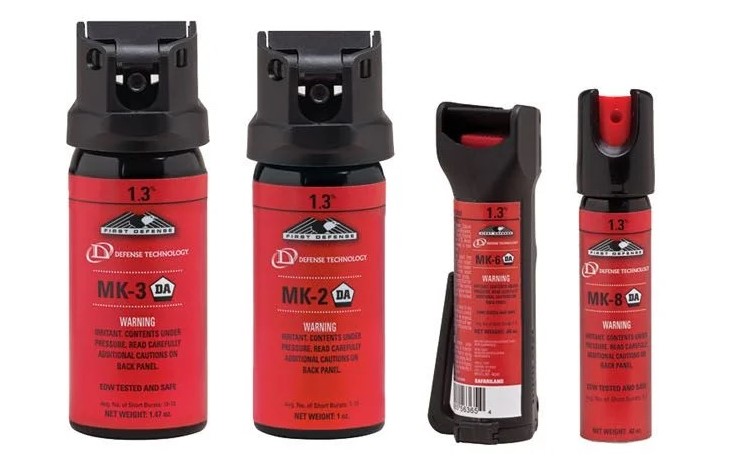Even if you carry a firearm, pepper spray is a less-lethal option that can allow you to defend yourself when confronted by someone who is unarmed but still dangerous. If the only tool at your disposal is a gun, you may save your own life, but you’ll take another and you may be subject to years of legal fees, bad press, protestors, blacklisting, or even imprisonment. Even if you were ethically justified and the law rules in your favor, your life could still be ruined.
Pepper spray can also be carried in places where guns are not allowed, and pepper spray is more socially acceptable than firearms. No one is going to panic or call the police if you carry a can of pepper spray in a parking lot or if a canister pokes out of your pocket.
The best kinds of pepper spray are those that are pure oleoresin capsicum (OC), without any chemical fillers, ideally with a major capsaicinoid content percentage close to the maximum of 1.4%. Only buy peppers sprays with a publicly listed major capsaicinoid content (MCC) and a published safety data sheet (SDS) or material safety data sheet (MSDS). Choose a canister with a flip-top safety, like the standard MK-6 canister, which is well-sized and has a reliable safety that won’t accidentally discharge or stump you in an emergency. You can also buy an accompanying inert canister to practice with.
OC is also effective against animals, but you’ll want a weaker formulation for dogs and special formulas for bears. We prefer UDAP bear spray, as the company was founded by a man who survived a bear attack thanks to bear spray. Plus, the UDAP sprays include a holster, which is key because you always want your spray at the ready when in bear country.
The most important stuff:
- You should carry pepper spray for self-defense, even if you carry a gun
- Pepper spray is more socially acceptable, less threatening, and allowed in more place than guns
- There are many chemicals that can be used in defense sprays. The best is pure capsicum or OC.
- When evaluating pepper spray strength, focus on the Major Capsaicinoid Content percentage, which is a more accurate measure of potency than the total OC percentage.
- Choose a pepper spray with a Major Capsaicinoid Content of 1.3% or higher
- Only buy peppers sprays with published MCC and an MSDS or SDS
- There are many different types of canisters. The best is MK-6, which has a reliable, easy-to-use safety.
- It’s best to choose a spray that is non-flammable
- There are many types of spray patterns. Stream is best for most. Avoid gels, which take longer to work.
- Pepper spray has a shelf life—usually 3 to 4 years. Replace it by the expiration date.
- Keep pepper spray at room temperature and out of extreme temperatures
- You can purchase an inert canister and practice your technique, just as you would with a gun or martial art
After 10 hours of research, including reviewing 20+ products, these are top choices to help shortcut your shopping. The picks are pure oleoresin capsicum with a major capsaicinoid content close to the maximum of 1.4%. They are non-flammable, deploy from safe but easy to operate canisters, and are highly effective.
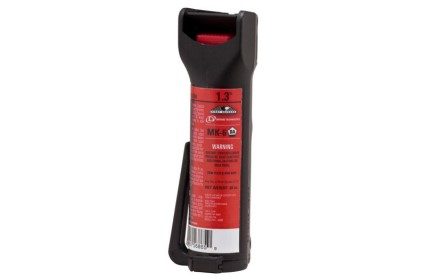
Best for most:
Defense Technology Mk-6
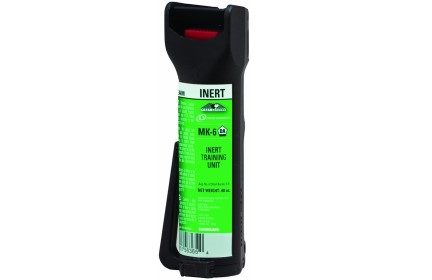
Essential for training:
Defense Technology Mk-6 Trainer
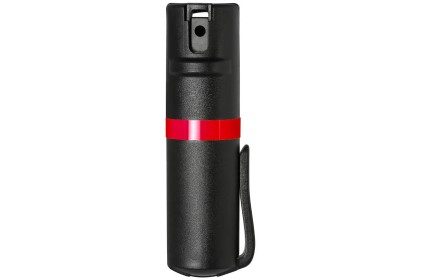
Compact option:
POM Pepper Spray
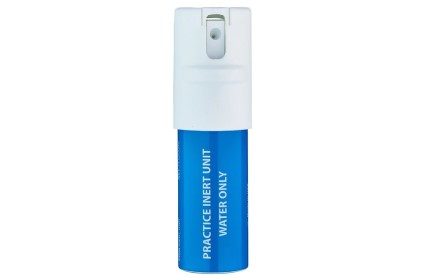
Essential for training:
POM Inert Trainer
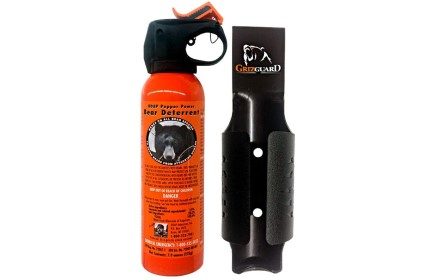
Bear protection:
UDAP Bear Spray
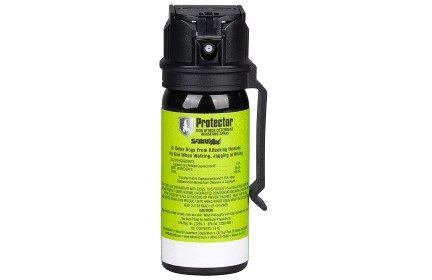
Canine protection:
SABRE RED Maximum Strength Pepper Spray Dog Attack Deterrent
Contenders
Although not currently top picks, these models are worth a look if you want more shopping options:
For self-defense / intended to be effective on people:
- Fox Labs Flip Top
- Fox Labs FX156 MGS Mean-Green
- FREEZE + P NF
- Mace Brand Pepper Spray Gun
- UDAP Mugger Fogger
- Vexor Self Defense Pepper Spray
For bears / wildlife:
- Bear Guard Alaska Bear Pepper Spray 9 oz
- Counter Assault Bear Deterrent 10.2 oz
- Frontiersman 7.9 oz, 30 ft range
- Frontiersman 9 oz, 35 ft range
- UDAP 18HP Super Magnum Bear Spray 13.4 oz
Be prepared. Don’t be a victim.
Want more great content and giveaways? Sign up for The Prepared’s free newsletter and get the best prepping content straight to your inbox. 1-2 emails a month, 0% spam.
What is defensive spray made from?
Defensive sprays are known by different informal names, most commonly pepper spray and Mace. Mace is actually a brand name that has become synonymous with defensive sprays, like Xerox for copiers or Google for internet search.
There are three chemicals commonly used for defensive sprays:
- Oleoresin Capsicum (OC): Usually referred to as OC or capsaicin, this is the real deal “pepper spray,” as it’s derived from chili peppers. It causes a burning sensation in the eyes, skin, and mucous membranes.
- 2-chlorobenzalmalononitrile (CS): This is what people usually mean when they say “tear gas,” although it is a powder and not a gas, and all of these substances are used for riot control. It has similar effects to OC, causing eye irritation and even vomiting, but works much more slowly.
- Phenacyl chloride (CN): CN is an older chemical for defensive sprays and tear gas and has fallen out of favor due to both being more dangerous than OC and CS and less effective against those with a high tolerance for pain.
There are other less-common chemicals used, such as chloropicrin (PS), bromobenzylcyanide (CA), and dibenzoxazepine (CR).
We’ll focus on OC and CS, which are the most common defensive sprays, with OC being preferred for its availability and effectiveness. Some sprays combine OC and CS so you get the “best” of both worlds, but CS is slower to take effect than OC and the CS actually dilutes the effectiveness of the OC.
OC is measured in a few different ways. One is Scoville Heat Units (SHU), which measure the spiciness of foods and other substances. A cayenne pepper can have up to 50,000 SHU, a habanero might have up to 350,000 SHU, and the dreaded ghost pepper has about 1,000,000 SHU. Even the weakest pepper spray intended for use against humans is much spicier than that, anywhere between 2 and 5 million SHU, or possibly more.
Another way to measure OC is through total percentage, though a much more effective way is through the percentage of Major Capsaicinoid Content (often abbreviated as MCC). Pepper sprays intended for use against humans range between 0.18% to 1.4% major capsaicinoids. The total percentage just tells you how much pepper is in the can, while the capsaicinoid percentage tells you just how hot that pepper is. You should buy the strongest strength possible.
Defense trainer Chuck Haggard is considered the expert on pepper spray defense, and he says to only buy products for which the manufacturer provides MSDS/SDS safety sheets on their website and to only buy products with the MCC listed.
Just as important as the chemical irritant are the additives in the spray. Every defensive spray requires a propellant. Most now use an inert gas, but some still use butane, which is flammable. Some sprays contain alcohol or other flammable chemicals as solvents.
Pepper sprays typically use oil or water as a base. Since capsaicin is itself an oil, it’s a more effective carrier. There is no risk of the capsaicin separating from an oil base, and since oil spreads, that means it more effectively delivers the capsaicin, it lasts longer, and it’s harder to wash off. However, oil can also be flammable.
Ideally, choose a non-flammable spray to avoid unintentional fires, like if the spray comes into contact with a stun gun or TASER.
Some sprays include bright chemical dyes to mark an attacker. Others include UV dyes that are invisible unless exposed to ultraviolet light. However, these may be restricted by law in your area. If you go for a colored dye, avoid red, as it could be confused for blood and unnecessarily escalate a situation.
How is pepper spray delivered?
Beyond chemical composition, another important distinguishing feature of defensive sprays is their spray pattern. Each has its own pros and cons.
- Spray: Often called cone or fog, aerosol sprays disperse a cloud up to eight feet that is highly effective since it can be breathed in, can be used against multiple targets, and can be sprayed to create a defensive barrier. But it may also blow back in your direction or hit innocent bystanders.
- Stream: Like a squirt gun of pain, streams can hit up to 20 feet away. There is less risk of contamination or blow back, though it could still splash back on you in confined spaces. Streams also take more aim than aerosols, which could put you at a disadvantage if you’re panicking.
- Foam: Spray foams are intended for close distances, up to eight feet. There is less chance of contamination with foams, which cover an attacker, causing severe pain with minimal respiratory effects.
- Gels: A newer delivery method, gels are like foams in that they minimize contamination and blowback and stick to an attacker. But gels can travel distances up to 25 feet. The big downside of gel is that it can take up to two minutes to take effect.-*
Which one you choose is a matter of preference. Experts recommend trying inert practice canisters in different patterns to see what works best for you. That being said, experts warn against gels due to their slowness and often recommend streamers for their distance and lower risk of contamination versus sprays. There are also anecdotal (and questionable) reports of attackers scraping off gels and foams and throwing them back. However, gels are often used in confined areas, like hospitals.
Despite maximum distance claims, all defensive sprays lose effectiveness at distance. They’re best used within 5-8 feet (that’s for humans, bears are another story).
Another delivery method is pepper balls, which are shot from a gun or some other projectile device. They are more expensive and complicated than sprays and could be mistaken for a firearm, so while they have their uses, we won’t discuss them in this guide.
What does pepper spray do and how long does it last?
OC can cause a long list of unpleasant things:
- Excruciating pain in eyes, on skin, and in mucous membranes
- Temporarily blindness
- Difficulty breathing
- Coughing and gasping
- Blisters, in extreme cases
The great thing about OC is that it is effective even if the attacker is under the influence of drugs or alcohol.
However, just because pepper spray isn’t as lethal as a gun or a knife, that doesn’t mean you should spray it indiscriminately. Pepper spray’s effects can last anywhere from 30 minutes to hours, and while rare, pepper spray has been linked to deaths when used against people with preexisting conditions like asthma.
That being said, pepper spray is generally safe, non-lethal, and does not cause long-term effects. There are many military and police instructors who are regularly hit with pepper spray with no ill effects, and some even build up a tolerance to it. Law enforcement studies have shown that pepper spray reduces injuries both for law enforcement officers and suspects.
Can I use bug spray instead?
No. A lot of people think they can somehow cheap out by using hornet spray instead. Don’t do this, unless you’re in some extreme life or death situation. Pepper spray is cheap, effective, and generally safe, unlike bug spray, which is poison.
Does pepper spray expire?
Yes. The propellants lose their effectiveness over time. Your spray should have an expiration date on it and you should replace the canister before that date. Test your pepper spray a couple of times per year to make sure that it still sprays effectively. Make sure to do so outdoors on a non-windy day. It’s also a good practice to regularly shake the canister to keep the contents mixed.
Always keep pepper spray at room temperature. Do not leave it in a car. In high temperatures, the can could leak or explode. Cold temperatures may prevent it from spraying effectively. Keep pepper spray away from children and animals.
Is pepper spray legal?
Check your state and local laws, but OC is legal in all 50 states. However, there are a few state restrictions to be aware of. Pepper spray vendors typically do not ship to Alaska, Washington DC, Hawaii, Massachusetts, or New York due to restrictions in those areas. Here are some other restrictions to be aware of:
- California: Containers cannot contain more than 2.5 ounces of defense spray.
- Michigan: Spray cannot have more than 18% capsaicin content.
- New York: Spray cannot have more than 0.67% capsaicin content.
- New Jersey: Spray cannot have more than three-quarters of one-ounce of active ingredient.
- Virginia: Negligent discharges of noxious gasses, even accidental ones, can be a felony.
- Wisconsin: OC can have a maximum concentration of 10%, with a maximum total weight of 15-60 grams. Canisters cannot be camouflaged to look like another object like lipstick or a pen, and must have a safety mechanism. Also, formulations with CN and CS are not allowed.
And while this isn’t true in every state, pepper spray is generally restricted to those 18 years of age or older.
It is your responsibility to be aware of the applicable laws in your area. One of your best resources is your local gun store. The employees are usually well-versed not only in the local self-defense laws, but also in how they are enforced.
Be aware that using pepper spray, even in self-defense, could expose you to civil or criminal legal action. A good rule of thumb when deciding to use a weapon against someone is to ask yourself if it’s worth going to prison over? That said, the consequences of using pepper spray are much less severe than a firearm.
How do I prevent accidental discharges?
In addition to not storing pepper spray in a hot car, choose canisters that feature safeties. However, some safeties use complicated mechanisms like flip-to-side that you may fumble with when stressed or may become disengaged in a pocket or purse.
The experts recommend MK-6 dispensers, which are produced by several manufacturers. They use a reliable but easy to use flip-top and come in a convenient but capable size. Your pepper spray canister doesn’t exactly have to be an MK-6, but it should have a flip-top safety.
Many defense experts also like the POM pepper spray canisters, which are smaller than the MK-6 design but also feature a flip-top safety.
What do I do if I get pepper-sprayed?
Resist the urge to touch your face, with the exception of removing any contact lenses, which you should do immediately. Otherwise, touching your face will spread the pepper oils. Do not rub your eyes, as that could damage your corneas. Force yourself to blink, and rinse your eyes and skin with water. Some recommend milk, milk of magnesia, or baby shampoo, but water is just as effective. Blow your nose repeatedly and remove any clothing or jewelry that could make breathing difficult. Do not apply any oils, creams, or salves, as that could trap the pepper.
More: Milk does not treat tear gas but helps a little with pepper spray
Above all, remain calm and don’t panic. You may be in agonizing pain, but it’s only temporary and there should be no lasting effects.
Do I need to practice with pepper spray?
YES, just as you would with a firearm or martial art, you should practice your pepper spray technique. Top manufacturers sell inert practice canisters that spray a non-irritating solution. You can buy one along with your pepper spray and practice with it:
- Aim at the face (a target dummy helps)
- Use short, controlled bursts
- Practice a defensive stance. Back up, bend your knees, and lower your center of gravity.
Take a pepper spray class with a skilled instructor, if you can. It could save your life.
Can I use pepper spray on animals?
Yes, but there are some things you need to know. Dogs are especially sensitive to pepper spray. If you regularly find yourself in situations where you encounter aggressive dogs, you can equip yourself with a pepper spray formulated specifically for dogs. These sprays are weaker than the ones made for people but still effective. While human pepper spray is practically unregulated, dog sprays are regulated by the Environmental Protection Agency and cannot contain more than 1% MCC.
Bears are another potentially dangerous animal that can be thwarted with pepper spray, but not any pepper spray will do. There are specially formulated bear sprays that have much farther distances. Bear sprays also use a fog pattern because a stream will not work.
If you’re a hunter or other sort of gun person, you may think you don’t need bear spray, or that bear spray is some nonsensical hippy invention, but you couldn’t be more wrong. Studies have shown that guns are practically useless against bears in defense situations. Meanwhile, bear spray is 92-98% effective in deterring bear attacks.
When choosing a bear spray, you want an EPA-approved one that has at least 7.9 ounces of content that can spray in a wide fog at up to 30 feet for seven seconds or more. Keep the can ready when hiking, and just as with human pepper spray, practice with an inert can.
If you find yourself in a showdown with a bear, remember that bears are fast. You’ll want to deploy the spray well before the bear gets close.
Before taking bear spray to a national or state park, check the rules first. Some prohibit bear spray while others encourage it.
Can I use bear spray against people?
It’s not recommended. Bear spray is formulated to be somewhat weaker than pepper spray, so while it may work against an attacker, it might also just piss them off. Pepper spray is cheap!
